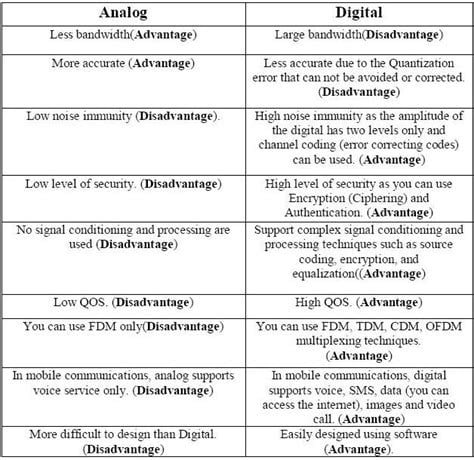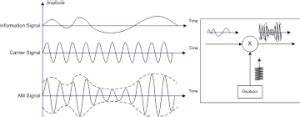Introduction to Modulation Techniques
Modulation is the process of varying one or more properties of a periodic waveform, called the carrier signal, with a modulating signal that typically contains information to be transmitted. The main purpose of modulation is to enable the transmission of information over a communication channel, such as a cable or the air. There are various modulation techniques used in digital communication systems, each with its own advantages and disadvantages. In this article, we will focus on two popular modulation techniques: Pam4 (Pulse Amplitude Modulation 4-level) and NRZ (Non-Return-to-Zero).
What is Pam4 Modulation?
Pam4, or Pulse Amplitude Modulation 4-level, is a digital modulation technique that uses four distinct voltage levels to represent two bits of data per symbol. In Pam4, the four voltage levels are typically denoted as -3, -1, +1, and +3. Each voltage level corresponds to a unique two-bit combination, as shown in the table below:
| Voltage Level | Bit Combination |
|---|---|
| -3 | 00 |
| -1 | 01 |
| +1 | 11 |
| +3 | 10 |
By using four voltage levels, Pam4 can transmit two bits per symbol, effectively doubling the data rate compared to binary modulation schemes like NRZ.
Advantages of Pam4 Modulation
- Higher data rate: Pam4 can achieve twice the data rate of binary modulation schemes like NRZ, making it suitable for high-speed communication systems.
- Spectral efficiency: Pam4 utilizes the available bandwidth more efficiently than binary modulation schemes, as it can transmit more bits per symbol.
- Reduced inter-symbol interference (ISI): The four voltage levels in Pam4 are spaced further apart compared to binary modulation, which reduces the impact of ISI caused by the channel.
Disadvantages of Pam4 Modulation
- Increased complexity: Pam4 requires more complex transmitter and receiver circuits compared to binary modulation schemes, as it needs to generate and detect four distinct voltage levels.
- Higher signal-to-noise ratio (SNR) requirement: To maintain the same bit error rate (BER) as binary modulation, Pam4 requires a higher SNR, which can be challenging to achieve in noisy environments.
- Sensitivity to non-linearities: Pam4 is more sensitive to non-linearities in the communication channel, such as amplifier distortion, which can degrade the signal quality.
What is NRZ Modulation?
NRZ, or Non-Return-to-Zero, is a binary modulation technique that represents data using two voltage levels, typically denoted as 0 and 1. In NRZ, a logic ‘1’ is represented by a high voltage level, while a logic ‘0’ is represented by a low voltage level. The voltage level remains constant for the entire duration of a bit period, and there is no return to zero voltage level between consecutive bits of the same value.
Advantages of NRZ Modulation
- Simplicity: NRZ is a simple modulation technique that requires minimal hardware complexity for both transmitter and receiver circuits.
- Low bandwidth requirement: NRZ has a relatively low bandwidth requirement compared to other modulation techniques, making it suitable for lower-speed communication systems.
- Robustness: NRZ is more robust against noise and distortion compared to multi-level modulation schemes like Pam4, as it uses only two voltage levels.
Disadvantages of NRZ Modulation
- Lower data rate: NRZ can only transmit one bit per symbol, resulting in a lower data rate compared to multi-level modulation schemes like Pam4.
- Clock recovery: NRZ does not have a self-clocking feature, which means that the receiver must have a separate clock recovery mechanism to synchronize with the transmitter.
- DC component: NRZ has a significant DC component in its spectrum, which can cause baseline wander and complicate the design of the AC-coupled stages in the communication system.
Comparison of Pam4 and NRZ Modulation Techniques
Data Rate
One of the main differences between Pam4 and NRZ is the achievable data rate. Pam4 can transmit two bits per symbol, effectively doubling the data rate compared to NRZ, which can only transmit one bit per symbol. This makes Pam4 more suitable for high-speed communication systems that require higher data rates.
For example, consider a communication system with a symbol rate of 10 Gsymbols/s (Gigasymbols per second). Using NRZ modulation, the maximum achievable data rate would be 10 Gbps (Gigabits per second), as each symbol represents one bit. However, using Pam4 modulation, the maximum achievable data rate would be 20 Gbps, as each symbol represents two bits.
Spectral Efficiency
Spectral efficiency is a measure of how efficiently a modulation technique utilizes the available bandwidth. It is defined as the ratio of the data rate to the bandwidth required for transmission. Pam4 has a higher spectral efficiency compared to NRZ, as it can transmit more bits per symbol within the same bandwidth.
To illustrate this, let’s consider a communication channel with a bandwidth of 10 GHz. Using NRZ modulation, the maximum data rate that can be achieved within this bandwidth is 10 Gbps, resulting in a spectral efficiency of 1 bit/s/Hz. In contrast, using Pam4 modulation, the maximum data rate that can be achieved within the same bandwidth is 20 Gbps, resulting in a spectral efficiency of 2 bits/s/Hz.
Signal-to-Noise Ratio (SNR) Requirement
The signal-to-noise ratio (SNR) is a measure of the strength of the desired signal relative to the level of background noise. To maintain the same bit error rate (BER), Pam4 requires a higher SNR compared to NRZ. This is because the four voltage levels in Pam4 are closer together than the two voltage levels in NRZ, making it more susceptible to noise and distortion.
For example, to achieve a BER of 10^-12 (one error in a trillion bits), Pam4 may require an SNR of 18 dB, while NRZ may only require an SNR of 12 dB. This means that Pam4 needs a stronger signal or a lower noise level to maintain the same BER as NRZ.
Hardware Complexity
Pam4 requires more complex transmitter and receiver circuits compared to NRZ, as it needs to generate and detect four distinct voltage levels. This increased complexity can result in higher power consumption, larger chip area, and higher cost.
In contrast, NRZ has a simpler hardware implementation, as it only requires two voltage levels. This makes NRZ more suitable for applications that prioritize low power consumption, small form factors, and low cost.
Robustness to Channel Impairments
NRZ is generally more robust to channel impairments, such as noise and distortion, compared to Pam4. This is because NRZ uses only two voltage levels, which are further apart than the four voltage levels in Pam4. As a result, NRZ can tolerate a higher level of noise and distortion before the signal quality degrades significantly.
Pam4, on the other hand, is more sensitive to channel impairments due to its closely spaced voltage levels. Non-linearities in the communication channel, such as amplifier distortion, can cause the voltage levels to shift and overlap, leading to increased bit errors.

Applications of Pam4 and NRZ Modulation
Pam4 Applications
Pam4 modulation is widely used in high-speed communication systems, such as:
- Data center interconnects: Pam4 enables high-speed data transmission between servers and switches within a data center, supporting data rates of 50 Gbps, 100 Gbps, and beyond.
- Optical transport networks: Pam4 is used in optical communication systems to increase the capacity of long-haul and metro networks, enabling data rates of 200 Gbps, 400 Gbps, and higher.
- High-speed serial links: Pam4 is employed in high-speed serial interfaces, such as PCIe (Peripheral Component Interconnect Express) and USB (Universal Serial Bus), to achieve higher data rates while maintaining compatibility with existing infrastructure.
NRZ Applications
NRZ modulation is commonly used in various communication systems, such as:
- Ethernet: NRZ is used in Ethernet standards, such as 10BASE-T (10 Mbps), 100BASE-TX (100 Mbps), and 1000BASE-T (1 Gbps), for data transmission over twisted-pair cables.
- Fiber-optic communication: NRZ is employed in lower-speed fiber-optic communication systems, such as those based on the Synchronous Optical Network (SONET) and Synchronous Digital Hierarchy (SDH) standards.
- Wireless communication: NRZ is used in some wireless communication systems, such as Bluetooth and ZigBee, for low-power and short-range data transmission.

Frequently Asked Questions (FAQ)
-
What is the main difference between Pam4 and NRZ modulation?
The main difference between Pam4 and NRZ modulation is the number of voltage levels used to represent data. Pam4 uses four voltage levels to represent two bits per symbol, while NRZ uses two voltage levels to represent one bit per symbol. -
Which modulation technique offers a higher data rate, Pam4 or NRZ?
Pam4 offers a higher data rate compared to NRZ, as it can transmit two bits per symbol, effectively doubling the data rate. -
Which modulation technique is more spectrally efficient, Pam4 or NRZ?
Pam4 is more spectrally efficient than NRZ, as it can transmit more bits per symbol within the same bandwidth. -
Which modulation technique requires a higher signal-to-noise ratio (SNR) to maintain the same bit error rate (BER), Pam4 or NRZ?
Pam4 requires a higher SNR to maintain the same BER as NRZ, due to its closely spaced voltage levels. -
Which modulation technique has a simpler hardware implementation, Pam4 or NRZ?
NRZ has a simpler hardware implementation compared to Pam4, as it only requires two voltage levels for transmitter and receiver circuits.

Conclusion
In conclusion, Pam4 and NRZ are two popular modulation techniques used in digital communication systems, each with its own advantages and disadvantages. Pam4 offers higher data rates and better spectral efficiency compared to NRZ, making it suitable for high-speed communication systems. However, Pam4 also requires a higher signal-to-noise ratio and more complex hardware implementation.
On the other hand, NRZ has a simpler hardware implementation and is more robust to channel impairments, making it suitable for lower-speed communication systems and applications that prioritize low power consumption and cost.
The choice between Pam4 and NRZ depends on the specific requirements of the communication system, such as the desired data rate, available bandwidth, signal-to-noise ratio, hardware complexity, and cost constraints. Understanding the characteristics and trade-offs of each modulation technique is essential for designing efficient and reliable communication systems.

No responses yet